Ian Fellows has more than 20 years of experience in visual effects. He has worked at many studios such as Framestore and MPC before joining Outpost VFX in 2018. He has worked on shows such as Edge of Tomorrow, The Martian, Fantastic Beasts and Where to Find Them and Thor: Ragnarok.
How did you get into visual effects?
I started in VFX back in the late 90s before the big growth of the UK VFX scene. At the time there were few university courses offering courses in VFX and the computer equipment we were using was unbelievably expensive. I started as a runner for Computer Film Company and progressed through the ranks from there.
How did you get involved on this movie?
Originally my colleague and overall VFX Supervisor for News of the World, Roni Rodrigues, was due to supervise the show internally. But halfway through shooting he was invited to become the client-side supervisor based in London and so I was brought on board to run and oversee the team internally along with Producer Josh Sykes and CG Supervisors Craig Tonks and Andy Morley.
How was the collaboration with Director Paul Greengrass?
I would describe the collaboration with Paul as fluid, creative and collaborative. We had a very unique relationship on this show with the director and editorial team due to Outpost being the sole vendor and our own supervisor Roni working directly with Paul throughout. This allowed for a very transparent flow of communication without some of the usual tiers of hierarchy found in the process of VFX filmmaking. Paul has a very fluid style of working and so we found we needed to develop an approach that allowed us to be flexible in order for him to explore and develop various aspects of the story he was telling.
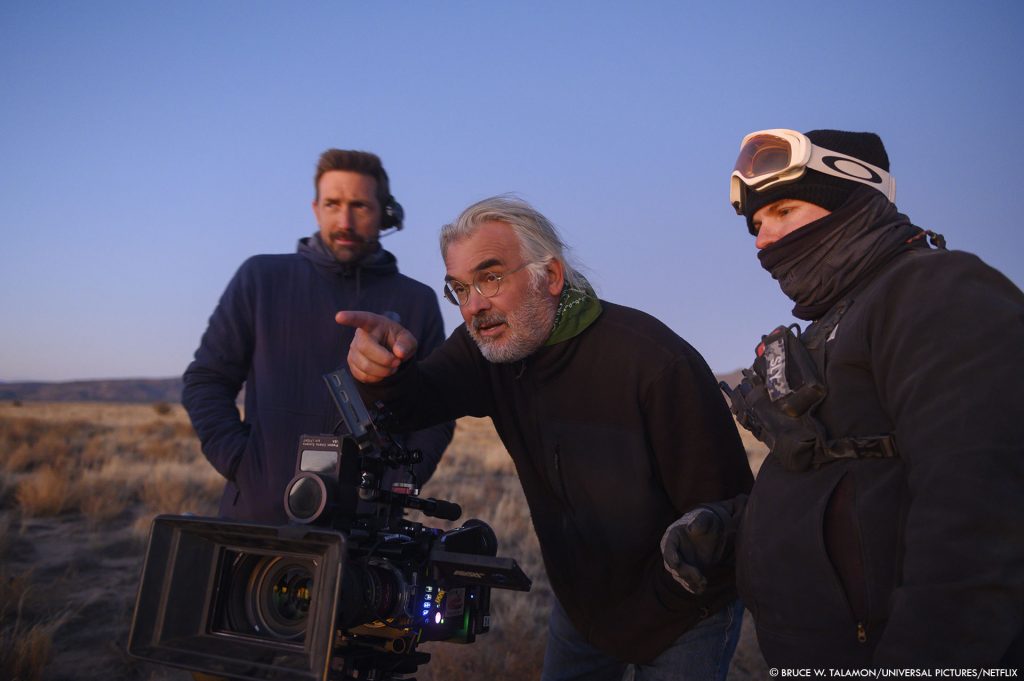
What was his approach and expectations about the visual effects?
Paul is known for his immersive and realistic storytelling style so it meant that any visual effects would need to be invisible and serve the purpose of enhancing the story rather than being a feature of the film. Paul is very embracing of visual effects and I think we had a great mutual understanding of how the VFX would complement his vision and allow him to portray his story when the locations or physicality of the action meant it wasn’t possible to catch the scene entirely in camera. Paul was always very pleased with our work as a whole and very vocal about recognising the hard work that the Outpost team was undertaking, which made for a very rewarding experience!
How did you organize the work with your VFX Producer?
There was a great variety of work in this film, and with it all happening in the middle of the pandemic organising the work and the teams was a challenge! For the large part we had a very fluid schedule at one level, whilst prioritising certain assets or work that we felt was going to be sensitive to Paul at various points in the process. There were frequent deliveries for client screenings and the like. Every day produced something unexpected that we needed to overcome!
What are the main challenges with a Western movie?
Well this is the first Western movie I’ve worked on in 20 years of working in VFX! But I think for us the main challenges in this movie were that the VFX needed to be thoroughly believable and invisible. Coupled with this, there was a huge variety of work that you wouldn’t necessarily anticipate, from portraying different towns to building cattle, horses, digi-doubles, CG rivers, sandstorm simulations, CG rain, face replacements and much more.
We discover many towns in the movie. What was the real size of these sets?
Three of the towns featured in the film were shot at the Bonanza Ranch in New Mexico. The main set was based around one street with a few side streets. There were probably somewhere in the region of 20 buildings and a church. San Antonio, on the other hand, didn’t exist at all and was all shot in a casino parking lot!
Can you explain in detail about the creation of these towns?
The first town we see is Red River. Using the Bonanza set we were tasked with increasing the width of the town and adding a large flooded river running around the edges. Paul described this town as a highway for cattle. The largest shot was an aerial flyover with cattle entering the town. The photography for this was acquired after the filming had finished and so there were no actors, cattle or props in the town, so these all had to be created by our 3D team and integrated with the photography to create the feel of a bustling cattle town.
Dallas was the biggest town and was also shot at the Bonanza Ranch. This was a big bustling city and the work was to extend the streets to make them a lot longer as well as adding another storey in height to the buildings. We also added lots of additional town life and atmospherics. The final results were achieved via combination of CG buildings and matte paintings in the rear as well as crowd elements.
San Antonio was a complete CG build for all the buildings including the church. We also had to create a market and add town life composited from shot elements. The primary photography was shot in a parking lot and the only set that was captured in camera was a small strip of wall for the graveyard and a narrow strip of sand as the floor. Of all the towns this one represented the most challenging work for our artists.
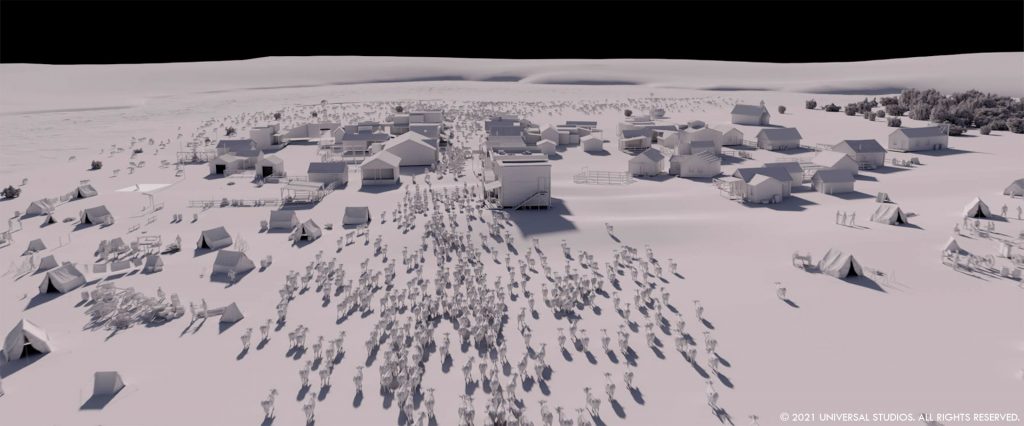
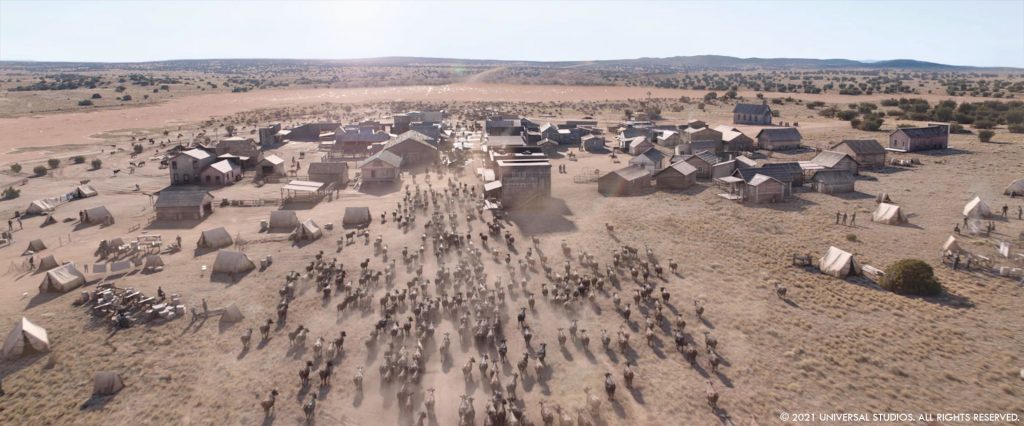
What kind of references and influences did you received for the town?
We used a lot of historical drawings and maps for our references and influences. Due to the period we were portraying there was only limited photography, however we were also able to find more recent images of the towns and combined with the drawings and old photos were able to unpick how the towns might have looked. Roni and the production team were able to provide us with some reference and history packs and then we also did a lot of our own architectural research.
How did you populate the towns with wagon, people and animals?
We populated the towns with a mixture of CG animals, wagons and props that our asset team built and also some real cattle and people that had been shot for purpose against blue screens. Some shots such as the aerial flyovers dictated an entirely CG approach, whereas in the case of Dallas we were able to use our blue screen elements to add most of the additional characters. A few of us even managed to sneak ourselves in the movie because we had to shoot a couple of custom crowd elements in our UK studio due to the pandemic!
Can you tell us more about the lighting work?
The lighting work was quite varied due to the range of different locations we were trying to portray. We had a large collection of HDRI images shot at various times in all of the locations thanks to the work of Roni, Andy and the rest of the team that went on set in New Mexico. For the large part we had central setups for each town for consistency, which could be tweaked on a custom basis when the shots required. We also had night setups for Dallas.
Which town was the most complicate to create and why?
Without doubt the most difficult town to create was San Antonio because literally nothing existed! But also as previously mentioned there was fairly sparse reference available and we had a large amount of creative control over the design of the town. This was rewarding but meant our design was continually evolving as we went. We weren’t really working to concept art or a pre-determined design for the town other than what we’d seen from some reference materials. Fortunately we seemed to lock into Paul’s ideas for how the town should be portrayed very early on which meant we had freedom to explore the development of the architecture and assets.
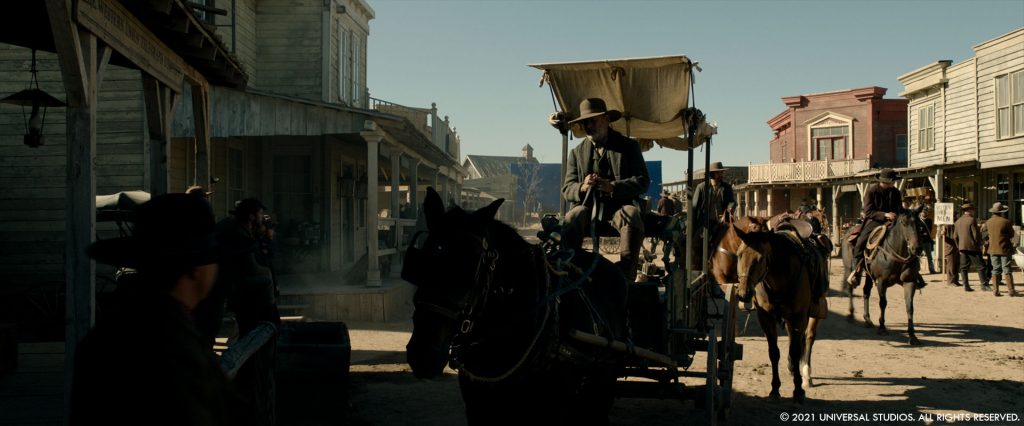
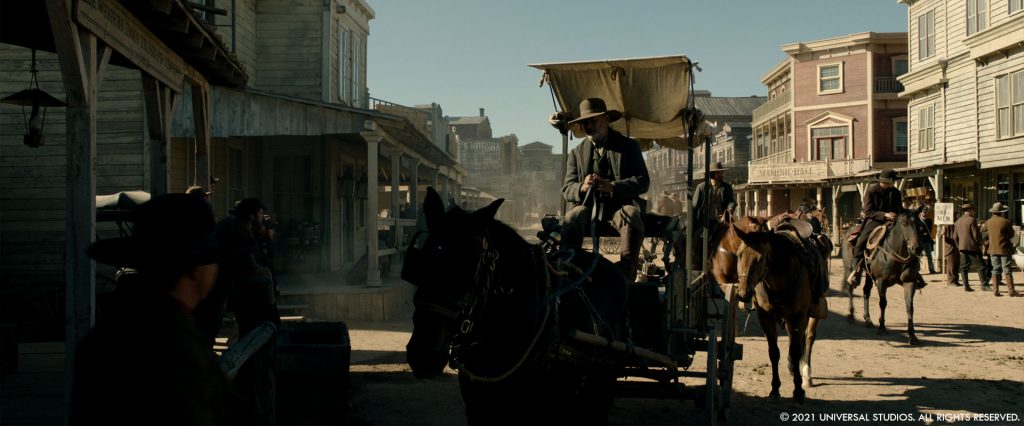
Can you elaborates about the intense night sequence along the river?
Internally we know the sequence as Johanna Calling, where Johanna is trying to signal to her Kiowa people that she is lost. This was shot fairly late in the schedule and essentially when Kidd (Tom Hanks) arrives at the river’s edge it was actually shot against blue screen in another parking lot. We were tasked with creating an aggressive and dangerous river and the entire environment including the bank on to which Johanna was climbing and the bank on the far side of the river. We had a lot of back and forth with Paul and Roni to work out the balance of scale and aggressive properties of the river.
Roni shot separate elements of Johanna after shooting had wrapped against blue screen that were then composited into the CG environment. We developed an instancing and scattering system in Houdini to deploy all the foliage and various sizes of rocks. In 3D terms the environment covered a vast distance, which made the scenes quite heavy.
How did you create the FX elements for the rain and river?
The rain and river simulations were created in Houdini and rendered with Mantra. Because the river was a physical simulation, we found that in order to create certain characteristics for the waves we actually had to change the sculpt of the riverbed.
Sometimes in sculpting one area to address one set of issues it might have an adverse effect on the sim somewhere else, so it became quite a balancing act! We had two versions of the river; a very high-resolution simulation for close up detail and then a faster rendering lower res river that was blended for the more distant parts of the river.
The rain simulations were rendered in layers, which then had their look defined in the compositing process. We had to match our simulations to surrounding shots where a rain machine had been used. Due to cold conditions the whole of the river section had been shot dry as had the opening scenes of the film in Wichita falls. As well as generic rain fall we added individually crafted drops of water onto clothing, Kidd’s lantern and other props.
We can see Indians in an almost ghostly vision on the other side of the river. How did the night affects your lighting work?
The Kiowa people were actually shot in the day against blue screens and composited against the CG environments with carefully crafted layers of fog and atmospherics. Most of the look of this sequence was defined in comp. We rendered our environment closer to daylight levels and then graded and manipulated it in comp. We took this approach because the renders were so heavy that we wanted the flexibility to work on the look more fluidly and quickly, whilst retaining the control of how much detail we would see. At one point in the process the lightning was affecting the whole environment quite heavily so we ended up rendering multiple light sources that could be controlled and flashed on and off by the compositors.
The Kiowa people and their appearance at this point in the film were very important to Paul from a narrative perspective, and so it took some time to arrive at the final look that Paul wanted.
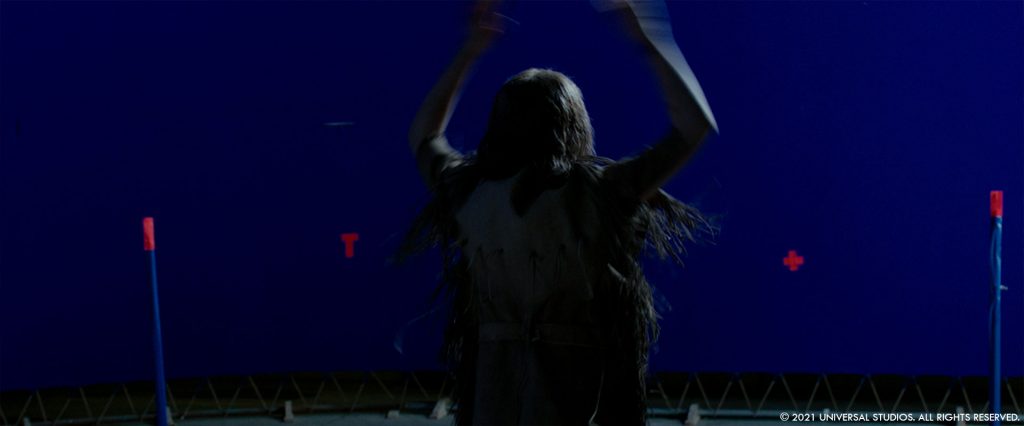
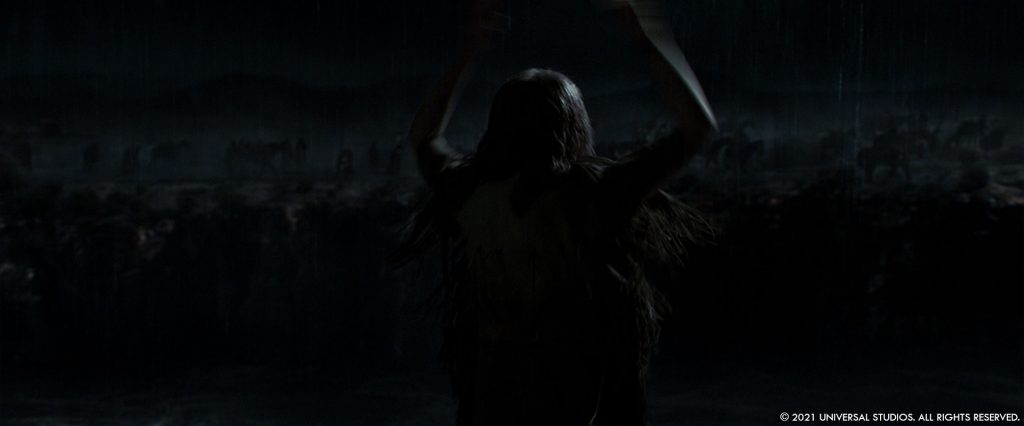
How did you work with the SFX and stunts teams?
The SFX teams provided a base layer of elements such as dust, which we then augmented further in post. This was common throughout the film. As the film is so grounded in reality, many of the practical effects in the film are just as invisible as the digital ones. For the sandstorm sequence, the SFX team used a fine dust and large fans on set to safely fill the air with debris, which we then enhanced. The most notable collaboration with the SFX team was for the wagon crash sequence.
Can you explain in detail about your work on the wagon crash?
The SFX team created a rigged cart that could be crashed down the side of the slope. The horses were CGI. We created faithful digital recreations of Kidd’s two horses from a host of reference photography that Roni captured on set and then we animated them falling in front of and behind the wagon.
We created FX dust and debris driven by the horse animation and the final comps combined all the components with further practically shot dust elements from our library of material.
For the dead horse, the stunt horse had actually been trained to lie still and pant, but on the day he wouldn’t perform so the dead horse was actually a dummy horse that we made to breathe in comp!
In the lead up to the crash we also had to significantly alter the environment to increase the sense of danger. Again this used our Houdini deployment system.
How did you create the massive dust storm?
This was a very challenging and complex body of work for relatively few shots in the movie. The massive wall of dust was created in Houdini and then passed to Maya and Arnold for lighting and rendering. The plate photography was entirely clean with no dust or wind.
We had lots of great reference from real-world sandstorms and also some reference from the SFX team. The biggest challenge for us was the sheer size of the dust cloud, which needed to pass over and through the camera. We ended up using a series of simulations and layers of different resolutions and particle densities that were blended together in comp along with some library elements.
Which sequence or shot was the most challenging?
Every single one! I was amazed at how far we progressed during the movie. This wasn’t our first film as sole vendor, but it was bigger than any we’d tackled before. By the time we reached the end we were knocking up with great speed additional VFX that would previously have proved a major challenge in their own right.
For obvious reasons the sandstorm and river sequences with their heavy FX requirements are definitely at the top of the list.
Did you want to reveal any other invisible effects?
We did a lot of environment work for the Dime Mountain shootout including lots of DMPs and foliage that you’ll struggle to notice without breaking the shots down.
We also did some pretty complex face replacements for the lead actors when riding carts or horses. Roni went to LA to shoot Hanks’s face from multiple angles and with multiple expressions that we then projected over facial maps we generated with Keen Tools for Nuke. The same goes for Johanna during the wagon sequences, and also for some of the Red River shots where she needed to be close to live cattle, which was unsafe for Helena Zengel to do herself.
One thing that features throughout the film that will probably go unnoticed is a huge amount of dust that we created as either a low-lying haze or directional clouds kicked up by wagons, horses and people. This was either achieved with a Houdini simulation or comped 2D elements.
We created cactus, buffalo, skinned buffalo, buffalo skulls, sky replacements, and falling boulders. The list is extensive!
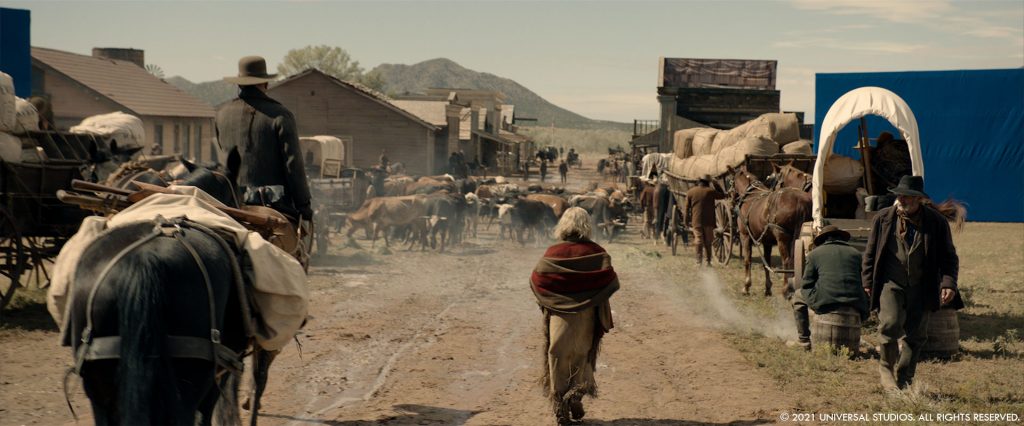
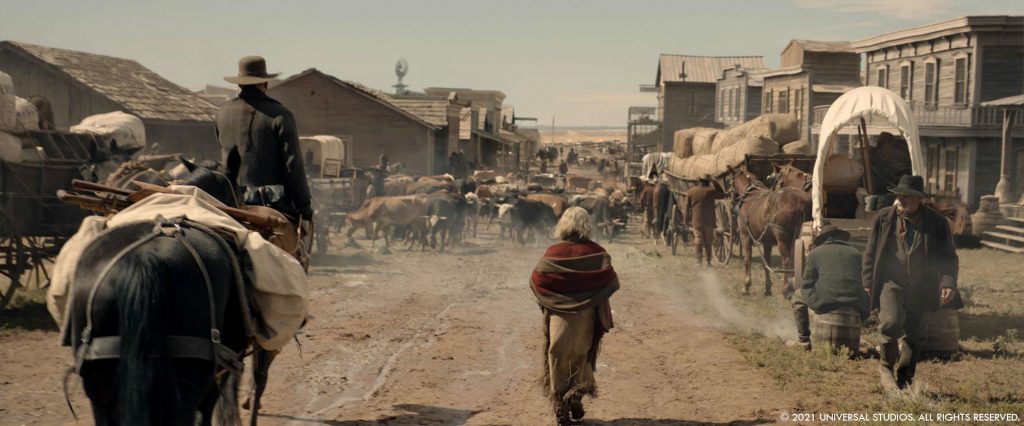
Is there something specific that gives you some really short nights?
Rivers and dust simulations keep me awake at night for sure.
What is your favorite shot or sequence?
For me that would be the Dallas sequence for its atmosphere and the San Antonio sequence. We’re very proud of our work on those two towns.
What is your best memory on this show?
The sense of achievement in delivering the biggest show to date at Outpost and the amazing team I had to work with. Oh and the late night pizza, beer and laughs!
How long have you worked on this show?
For me it was about 9 months.
What’s the VFX shots count?
Overall there were over 600 VFX shots, with Outpost tackling over 350 of those in total.
What was the size of your team?
At the shows peak we had about 55-60 artists working on the team. The comp team amounted to about 30 of those. The majority of our artists were working remotely, with a team of 15 or so remaining in the office.
What is your next project?
I’m currently working with Roni on a big series for Amazon that we can’t wait to show everyone!
A big thanks for your time.
// News of the World – VFX Breakdown – Outpost VFX
WANT TO KNOW MORE?
Outpost VFX: Dedicated page about News of the World on Outpost VFX website.
Netflix: You can watch News of the World on Netflix now (except US, Canada and other select territories).
© Vincent Frei – The Art of VFX – 2021






